
Falstaff is a comic opera in three acts by the Italian composer Giuseppe Verdi. The Italian-language libretto was adapted by Arrigo Boito from the play The Merry Wives of Windsor and scenes from Henry IV, Part 1 and Part 2, by William Shakespeare. The work premiered on 9 February 1893 at La Scala, Milan.

Roméo et Juliette is a seven-movement symphonie dramatique for orchestra and three choruses, with vocal solos, by French composer Hector Berlioz. Émile Deschamps wrote its libretto with Shakespeare's play as his base. The work was completed in 1839 and first performed on 24 November of that year, but it was modified before its first publication, in 1847, and modified again for the 2ème Édition of 1857, today's reference. It bears the catalogue numbers Op. 17 and H. 79. Regarded as one of Berlioz's finest achievements, Roméo et Juliette is also among his most original in form and his most comprehensive and detailed to follow a program. The vocal forces are used in the 1st, 5th and 7th movements.

La clemenza di Tito, K. 621, is an opera seria in two acts composed by Wolfgang Amadeus Mozart to an Italian libretto by Caterino Mazzolà, after Pietro Metastasio. Mozart completed the work in the midst of composing Die Zauberflöte, his last opera. La clemenza di Tito premiered on 6 September 1791 at the Estates Theatre in Prague.

Sly, ovvero La leggenda del dormiente risvegliato is an opera in three acts by Ermanno Wolf-Ferrari to an Italian libretto by Giovacchino Forzano, based on the Induction to Shakespeare's The Taming of the Shrew. It was premiered at La Scala in Milan in 1927.
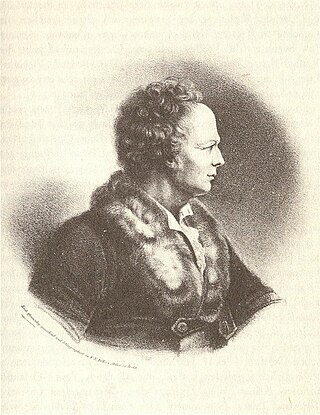
Le cinesi is an opera in one act, with music composed by Christoph Willibald Gluck. The Italian-language libretto was by Pietro Metastasio, and he described it as a componimento drammatico. This libretto had first been set by Antonio Caldara in 1735. For Gluck's rework, the piece is often considered as an azione teatrale, even though Metastasio and the composer both retained the original designation. The work was first performed for the Austrian royal family at the Schloss Hof on 24 September 1754, on the occasion of the visit of the Empress Maria Theresa to the household of Saxe-Hildburghausen.

Tarare is an opéra composed by Antonio Salieri to a French libretto by Pierre Beaumarchais. It was first performed by the Paris Opera at the Théâtre de la Porte Saint-Martin on 8 June 1787. Salieri also reworked the material into an Italian version retitled Axur, re d'Ormus with libretto by Lorenzo Da Ponte, which opened in Vienna in January 1788.
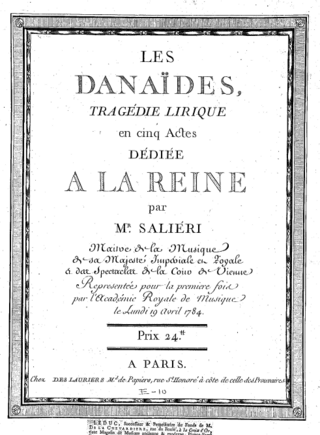
Les Danaïdes is an opera by Antonio Salieri, in five acts: more specifically, it is a tragédie lyrique. The opera was set to a libretto by François-Louis Gand Le Bland Du Roullet and Louis-Théodore de Tschudi, who in turn adapted the work of Ranieri de' Calzabigi. Calzabigi originally wrote the libretto of Les Danaïdes for Christoph Willibald Gluck, but the aged composer, who had just experienced a stroke, was unable to meet the Opéra's schedule and so asked Salieri to take it over. The plot of the opera is based on Greek tragedy and revolves around the deeds of the mythological characters Danaus and Hypermnestra.

La fiera di Venezia is a three-act opera buffa, described as a commedia per musica, by Antonio Salieri, set to an Italian libretto by Giovanni Gastone Boccherini.
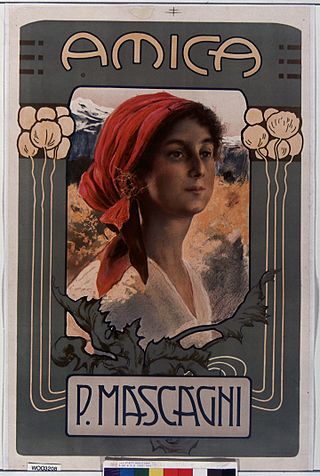
Amica is an opera in two acts by Pietro Mascagni, originally composed to a libretto by Paul Bérel. The only opera by Mascagni with a French libretto, it was an immediate success with both the audience and the critics on its opening night at the Théâtre du Casino in Monte-Carlo on 16 March 1905. Mascagni himself conducted the performance. The opera had its Italian premiere on 13 May 1905 at the Teatro Costanzi in Rome.

Didon (Dido) is a tragédie lyrique in three acts by the composer Niccolò Piccinni with a French-language libretto by Jean-François Marmontel. The opera is based on the story of Dido and Aeneas from Virgil's Aeneid as well as Metastasio's libretto Didone abbandonata. Didon was first performed at Fontainebleau on 16 October 1783 in the presence of the French sovereigns, Louis XVI and Marie Antoinette. After being remounted at court twice, the opera had its Paris public premiere on 1 December 1783. It proved to be the composer's greatest success and was billed almost every year till 1826, enjoying a total of 250 performances al the Paris Opera. Didon had some influence on Berlioz's opera on the same theme, Les Troyens.
Sir John in Love is an opera in four acts by the English composer Ralph Vaughan Williams. The libretto, by the composer himself, is based on Shakespeare's The Merry Wives of Windsor and supplemented with texts by Philip Sidney, Thomas Middleton, Ben Jonson, and Beaumont and Fletcher. The music deploys English folk tunes, including "Greensleeves". Originally titled The Fat Knight, the opera premiered at the Parry Opera Theatre, Royal College of Music, London, on 21 March 1929. Its first professional performance was on 9 April 1946 at Sadler's Wells Theatre.

Hélène is a poème lyrique or opera in one act by composer Camille Saint-Saëns. It is the first opera for which Saint-Saëns wrote his own French libretto, which is based on the classic story of Helen of Troy and Paris from Greek mythology. The opera premiered at the Opéra de Monte-Carlo in Monaco on 18 February 1904. Moderately successful, the opera enjoyed a handful of revivals up through 1919, after which it fell out of the performance repertoire. The work was resurrected in 2008 for its world premiere recording by the Australian music label Melba.

Il re is a novella or opera in one act and three scenes by composer Umberto Giordano to an Italian libretto by Giovacchino Forzano. The opera premiered at La Scala in Milan on 12 January 1929.

Medea is an opera in three acts composed by Giovanni Pacini to a libretto by Benedetto Castiglia. It premiered on 28 November 1843 at the Teatro Carolino in Palermo, conducted by the composer with Geltrude Bortolotti in the title role. The libretto is based on the plays Medea by Euripides and Médée by Pierre Corneille.
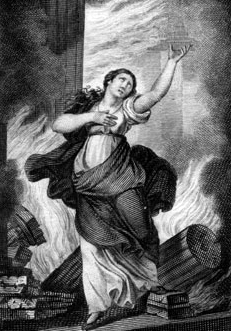
Didone abbandonata is an opera in three acts composed by Domenico Sarro to a libretto by Pietro Metastasio of the same name which was based on the story of Dido and Aeneas from the fourth book of Virgil's Aeneid. The opera premiered on 1 February 1724 at the Teatro San Bartolomeo in Naples.
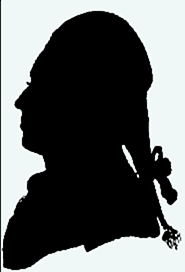
Vincenzo Calvesi was an Italian operatic tenor and impresario. A skillful lyric tenor, he began his career performing in opera houses in Italy during the 1770s. He was active in Dresden in 1782 to 1783 and then spent most of his time performing in Vienna from 1785 to 1794. He is best remembered today for creating the role of Ferrando in the world premiere of Wolfgang Amadeus Mozart's Così fan tutte in 1790. That same year the Viennese publication Grundsätze zur Theaterkritik described him as "one of the best tenors from Italy…with a voice naturally sweet, pleasant and sonorous." He was later active in Rome as an impresario up until 1811.

Gloria is a tragic opera in three acts by Francesco Cilea with an Italian libretto by Arturo Colautti. A variation on the Romeo and Juliet story and set in 14th century Siena, the libretto is based on Victorien Sardou's 1874 play La Haine (Hatred). The opera premiered on 15 April 1907 at La Scala conducted by Arturo Toscanini with Solomiya Krushelnytska in the title role. Gloria was a failure at its premiere when it was withdrawn after two performances and fared little better in the 1932 revised version, although there have been two late 20th century revivals. It proved to be Cilea's last staged opera. In the 43 years following the premiere of Gloria he worked on two or three further operas which were never performed and continued to compose chamber and orchestral music.
Adelaide di Guesclino is an opera in two acts composed by Simon Mayr. The Italian libretto by Gaetano Rossi is based on Voltaire's 1734 play Adélaïde du Guesclin. The opera premiered at La Fenice in Venice on 1 May 1799 with Caterina Angiolini in the title role.
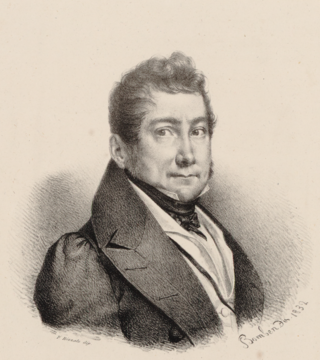
Caterina di Guisa is an opera in two acts by Carlo Coccia to a libretto by Felice Romani based on the 1829 play Henry III and His Courts by Alexandre Dumas. Caterina di Guisa premiered on 14 February 1833 at the Teatro alla Scala in Milan with triumphal success. A revised version, probably prepared to exploit at its best the different cast, was presented on 15 June 1836 at the Teatro Carignano in Turin. This opera is characterized by an "intensely dramatic score, rich in power and originality" and by a "heartrending finale".


















